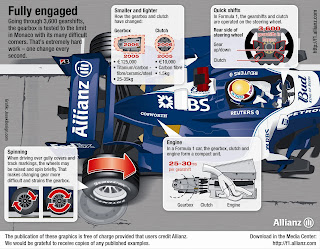 The transmission's job is to take the output of the engine, turning at 16-19k rpm and turn it into an output that matches the speed of the car's wheels. Most of the F1 cars today use seven forward gears. The engineers will designate each gear's ratio for each track during the season to make maximum use of the engine. Gear ratios are often changed several times during practice depending on things like wind and driver preference.
The transmission's job is to take the output of the engine, turning at 16-19k rpm and turn it into an output that matches the speed of the car's wheels. Most of the F1 cars today use seven forward gears. The engineers will designate each gear's ratio for each track during the season to make maximum use of the engine. Gear ratios are often changed several times during practice depending on things like wind and driver preference.In an F1 car, shifting is done by two paddles on the back of the steering wheel. Typically pulling the right paddle shifts up and the left paddle shifts down. The gears are selected sequentially, meaning the driver cannot skip gears, although they can pull the paddles rapidly to cycle through the gears. The clutch is only used to start the car from a stop. The electronics handle matching engine rpms and cutting power during the actual shift. The driver keeps his foot flat on the throttle. An up-shift takes less than 0.2 seconds. The clutch is also a paddle on the steering wheel since the left foot is used for braking, and there is not much room in the foot-well.
 In 2007 several teams started using so-called 'seamless shift' gearboxes. Normally on an up-shift the current gear is disengaged, the throttle is cut, the electronics wait for the engine revs to drop to the appropriate rpm, and then the next gear is engaged. In the seamless shift units, the waiting period for the revs to drop is no longer necessary. The seamless units use ratchets to allow the engine to engage the next higher gear without needing to be synchronized in speed. This reduces up-shift times to less than 0.1 seconds. Its also very hard on the transmission and the hydraulics that operate it, and 2007 has seen numerous gearbox failures.
In 2007 several teams started using so-called 'seamless shift' gearboxes. Normally on an up-shift the current gear is disengaged, the throttle is cut, the electronics wait for the engine revs to drop to the appropriate rpm, and then the next gear is engaged. In the seamless shift units, the waiting period for the revs to drop is no longer necessary. The seamless units use ratchets to allow the engine to engage the next higher gear without needing to be synchronized in speed. This reduces up-shift times to less than 0.1 seconds. Its also very hard on the transmission and the hydraulics that operate it, and 2007 has seen numerous gearbox failures.As with the monocoque, Allianz has published an excellent technical graphic on F1 gearboxes.
No comments:
Post a Comment